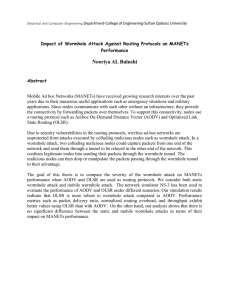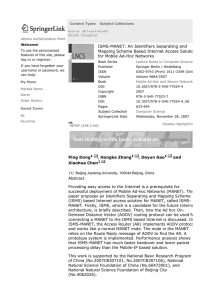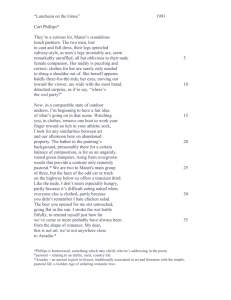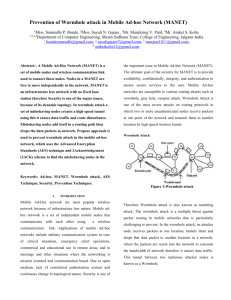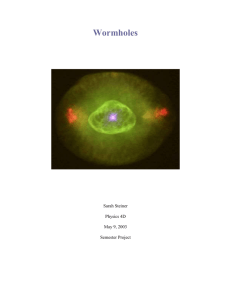Sophisticated Routing Protocols Survey in the Preety Thakur
advertisement
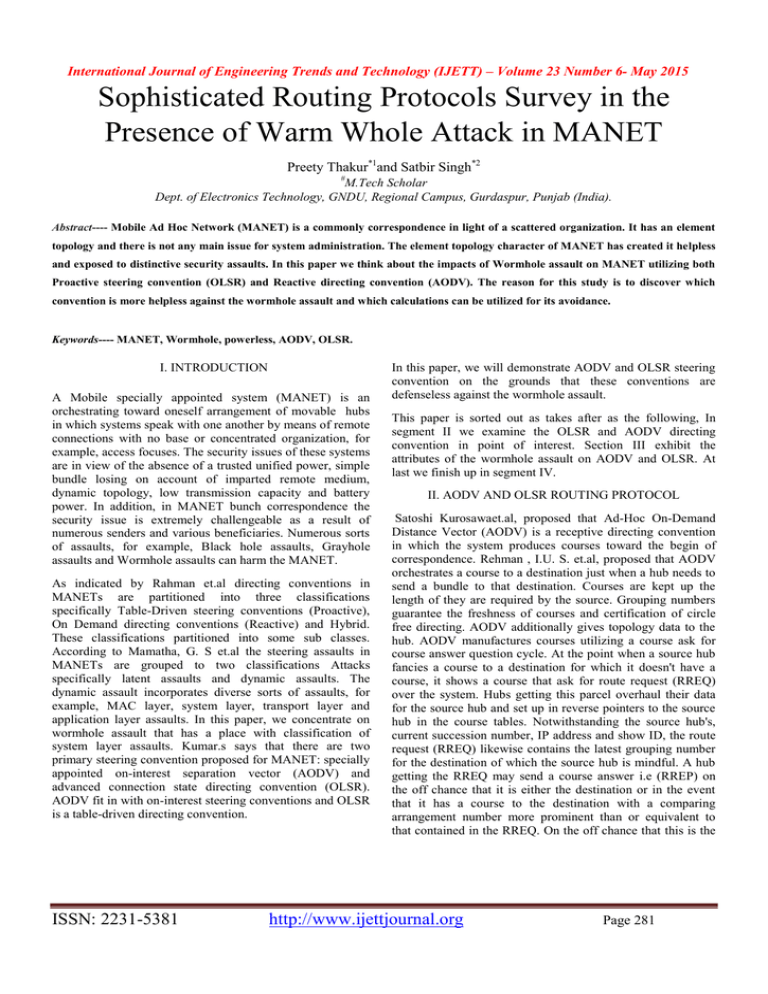
International Journal of Engineering Trends and Technology (IJETT) – Volume 23 Number 6- May 2015 Sophisticated Routing Protocols Survey in the Presence of Warm Whole Attack in MANET Preety Thakur*1and Satbir Singh*2 # M.Tech Scholar Dept. of Electronics Technology, GNDU, Regional Campus, Gurdaspur, Punjab (India). Abstract---- Mobile Ad Hoc Network (MANET) is a commonly correspondence in light of a scattered organization. It has an element topology and there is not any main issue for system administration. The element topology character of MANET has created it helpless and exposed to distinctive security assaults. In this paper we think about the impacts of Wormhole assault on MANET utilizing both Proactive steering convention (OLSR) and Reactive directing convention (AODV). The reason for this study is to discover which convention is more helpless against the wormhole assault and which calculations can be utilized for its avoidance. Keywords---- MANET, Wormhole, powerless, AODV, OLSR. I. INTRODUCTION A Mobile specially appointed system (MANET) is an orchestrating toward oneself arrangement of movable hubs in which systems speak with one another by means of remote connections with no base or concentrated organization, for example, access focuses. The security issues of these systems are in view of the absence of a trusted unified power, simple bundle losing on account of imparted remote medium, dynamic topology, low transmission capacity and battery power. In addition, in MANET bunch correspondence the security issue is extremely challengeable as a result of numerous senders and various beneficiaries. Numerous sorts of assaults, for example, Black hole assaults, Grayhole assaults and Wormhole assaults can harm the MANET. As indicated by Rahman et.al directing conventions in MANETs are partitioned into three classifications specifically Table-Driven steering conventions (Proactive), On Demand directing conventions (Reactive) and Hybrid. These classifications partitioned into some sub classes. According to Mamatha, G. S et.al the steering assaults in MANETs are grouped to two classifications Attacks specifically latent assaults and dynamic assaults. The dynamic assault incorporates diverse sorts of assaults, for example, MAC layer, system layer, transport layer and application layer assaults. In this paper, we concentrate on wormhole assault that has a place with classification of system layer assaults. Kumar.s says that there are two primary steering convention proposed for MANET: specially appointed on-interest separation vector (AODV) and advanced connection state directing convention (OLSR). AODV fit in with on-interest steering conventions and OLSR is a table-driven directing convention. ISSN: 2231-5381 In this paper, we will demonstrate AODV and OLSR steering convention on the grounds that these conventions are defenseless against the wormhole assault. This paper is sorted out as takes after as the following, In segment II we examine the OLSR and AODV directing convention in point of interest. Section III exhibit the attributes of the wormhole assault on AODV and OLSR. At last we finish up in segment IV. II. AODV AND OLSR ROUTING PROTOCOL Satoshi Kurosawaet.al, proposed that Ad-Hoc On-Demand Distance Vector (AODV) is a receptive directing convention in which the system produces courses toward the begin of correspondence. Rehman , I.U. S. et.al, proposed that AODV orchestrates a course to a destination just when a hub needs to send a bundle to that destination. Courses are kept up the length of they are required by the source. Grouping numbers guarantee the freshness of courses and certification of circle free directing. AODV additionally gives topology data to the hub. AODV manufactures courses utilizing a course ask for course answer question cycle. At the point when a source hub fancies a course to a destination for which it doesn't have a course, it shows a course that ask for route request (RREQ) over the system. Hubs getting this parcel overhaul their data for the source hub and set up in reverse pointers to the source hub in the course tables. Notwithstanding the source hub's, current succession number, IP address and show ID, the route request (RREQ) likewise contains the latest grouping number for the destination of which the source hub is mindful. A hub getting the RREQ may send a course answer i.e (RREP) on the off chance that it is either the destination or in the event that it has a course to the destination with a comparing arrangement number more prominent than or equivalent to that contained in the RREQ. On the off chance that this is the http://www.ijettjournal.org Page 281 International Journal of Engineering Trends and Technology (IJETT) – Volume 23 Number 6- May 2015 situation, it unicasts a RREP back to the source. Else, it rebroadcasts the RREQ. On the off chance that they get a RREQ which they have effectively prepared, they toss the RREQ and don't forward it. As the RREP spreads back to the source, hubs set up forward pointers to the destination. When the source hub gets the RREP, it may start to forward information parcels to the destination. On the off chance that the source later gets a RREP containing a more noteworthy succession number or contains the same arrangement number with a littler bounce check, it may overhaul its directing data for that destination and start utilizing the better course. The length of the course stays dynamic; it will keep on being kept up. On the off chance that a connection break happens while the course is finished. In the wake of getting the RERR, if the source hub still yearnings the course, it can reinitiate course revelation. C B D A E G H L I K Fig. 2 RREP Propagation Route (Route Reply) As indicated by Rahman et.al that Optimized Link State Routing convention (OLSR) is a proactive convention. This convention made upon connection state calculation. OLSR enhance a connection state convention and pack the data size of a send messages, and decline the retransmission bundles. OLSR has a property of having the courses promptly accessible when required; it is a result of its proactive nature. In a connection state convention, all the connections are announced to neighbor hubs and overwhelmed in the system. OLSR is an advancement of connection state convention for MANET. III. WORMHOLE ATTACK IN AODV AND OLSR Wormhole assault is an unsafe assault for MANETs. When accepting a vindictive hub parcel in this assault from one area in the system, it associate with different areas in the system, and now that its out in the open according to Mahajan et.al, these parcels are sent into the system redundantly. This association goes about as a wormhole for the passage interface two aggressors. In this assault Rai et.al displays that the aggressor make a wormhole relying upon the sort of system association (Wired or Wireless) notwithstanding for parcels with no locations to itself in light of the telecast way of these two sorts of systems. As indicated by Keer et.al , Wormhole assaults can be master minded effectively. For making a wormhole assault, not less than two handsets are situated at distinctive areas on a remote system by assailant. Likewise, after plan of a wormhole, an assailant can without much of a stretch befuddle direct to oversee parcels through the wormhole. Maulik et.al propounds the wormhole assaults into two of the accompanying gatherings: • In –band wormhole assault, which covers the current remote medium through a shrouded covering. Fig .1 Requests broadcast (Route request) • Out-of-band wormhole assault, which interface two threateningly hubs through equipment channel. A G F B H E C I Fig . 3 (a) in- band wormhole (b) out-of-band wormhole D ISSN: 2231-5381 http://www.ijettjournal.org Page 282 International Journal of Engineering Trends and Technology (IJETT) – Volume 23 Number 6- May 2015 IV. CONCLUSION In this study we analyzed the wormhole attack in malicious nodes network. In a network it is important for a protocol to be effective and efficient in term of security. Therefore, the application of MANET that uses proactive routing protocol is more trusted compared to the reactive one, when more than one attacker exists in the network. This paper also includes the prevention of wormhole attack using OLSR and AODV routing protocols. This research survey also presents the state of art of wormhole attack in MANET. For future work, we have recommended a novel solution that uses Bacteria Foraging Optimization (BFO) technique for optimizing the positions of multiple base stations randomly in the entire network to help in improving the likelihood of packets from sensor nodes reaching at least one BS in the network in the presence of large black hole regions, thus ensuring high success rate. REFERNCES [1 ] Rahman, M. A. et.al, “A Simulation Based Performance Comparison of Routing Protocol on Mobile Ad-hoc Network (Proactive, Reactive and Hybrid),” International Conference on Computer and Communication Engineering Kuala lumpur Malaysia,2010, IEEE. [2] Mittal, S. et.al , “Performance comparison of AODV, DSR and ZRP Routing protocols in MANETs,” International Conference on Advances in Computing, Control, and Telecommunication Technologies, 2009, IEEE. [3] Mamatha, G. S. , & Sharma, S. C.,” Network Layer Attacks and Defense Mechanisms in MANETS- A Survey,” International Journal of Computer Applications Volume 9(9). [4] Kumar, S. et.al, “AODV and OLSR routing protocols for Wireless Adhoc and Mesh Networks,” International Conference of computer and Communication Technology (ICCCT), 2010, IEEE. [5] Satoshi Kurosawa, et.al,.” Detecting Black hole Attack on AODV based Mobile Ad hoc networks by Dynamic Learning Method,” International Journal of Network Security, Vol.5, No.3, PP.338–346, Nov 2007. [6] Rehman, I.U et.al, “Analysis of Black Hole attack On MANETs Using different MANET Routing Protocols,” [Ronneby, 2010]. [7] Mahajan., Natu et.al, A., “Analysis of wormhole intrusion attacks in MANETs,” [2008, IEEE]. [8] Rai, A. K., et.al, “ Different Types of Attacks on Integrated MANETInternet Communication,” International Journal of Computer Science and Security (IJCSS) Volume (4) Issue (3) Nov 2010. [9] Keer, S.et.al. “To Prevent Wormhole Attacks Using Wireless Protocol in MANET,” International journal on computer and communication technology [2010, IEEE] [10] Maulik, R. et.al, “A Study on Wormhole Attacks in MANET,” International Journal of Computer Information Systems and Industrial Management Applications, 3, 2011. ISSN: 2231-5381 http://www.ijettjournal.org Page 283
